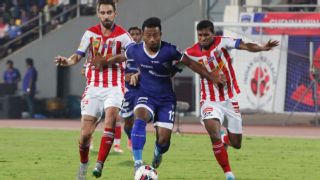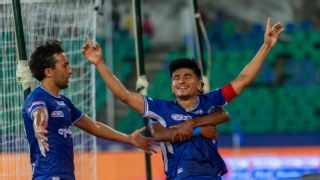|
It is a landmark year that the Indian Super League (ISL) will enter when Kerala Blasters host Bengaluru FC in the opening game of the league's 10th season on Thursday in Kochi. Perhaps, the most striking evolution of the ISL going into the 10th year of its existence has been it becoming India's top-division league, from fighting for space (and even players) with the I-League. Here's a look at how, gradually, over the last nine years, the 'Indian' has been put in the ISL. More teams, more opportunityThe ISL began as an eight-team, two-month, IPL-style tournament back in 2014. Teams were playing games every three or four days, necessitated by the tight window the league was operating in. It also had only 61 games in the whole season, compared to the 139 that will be played in the 2023-24 season. There weren't too many Indians playing in 2014 either, as the league allowed teams to have seven foreigners in their XI at any point. Those were also the days of only three substitutions being allowed, so in any game, only a maximum of seven Indians per team had any involvement on matchday. Now, teams need to have seven Indians on the pitch at any point in time. Game time is the most sure-shot way of improving players, and the recent performances (more than the results) tell you that Indian players have come a long way from 2014. The Indian progression - goals and otherwiseThe top Indian goalscorer in 2014 - Jeje Lalpekhlua - scored four times in the league. Only three other Indians managed to score more than once that season. Since then, in the eight seasons that have followed, more Indians have found the net, and more often than they did. Of course, Sunil Chhetri has been the top-scoring Indian in five out of the eight ISL seasons that he has played, but even outside of Chhetri, other Indian attackers have seen their stock catapult thanks to the trust being placed in them by their ISL managers, which wasn't the case when the ISL began in 2014. The league had 17 different Indian goalscorers in 2014. 2022-23 saw 51 different Indians find the net.  Even outside of the goals, more Indians getting chances to start in ISL games over the years has meant they've had more impact on games. The official player of the match in the ISL was won by an Indian 17 times in the 61 matches in 2014 (27%). That number went up to 47 times in 111 games in 2022-23 (42%). More Indians are playing and are winning their clubs games more often than when the league began. The national team's strongest suit has been helped by the ISLIt is not up for debate that right now, the goalkeeping position is where India have a variety of riches, even outside of Gurpreet Singh Sandhu and Amrinder Singh, who have played most for the national team under Igor Stimac. The likes of Prabhsukhan Singh Gill, Dheeraj Singh Moirangthem and Vishal Kaith generally find themselves fighting for one spot in the national squad, and that is a huge switch from 2014 when Indian goalkeepers were generally fighting for a place in their own ISL XIs.  Six of the eight teams in 2014 had foreign goalkeepers being their first choice - with only Arindam Bhattacharja for Pune City FC and Subrata Paul for Mumbai City FC playing more than 10 games that season. Former India and East Bengal coach Stephen Constantine had long questioned Indian clubs in not giving Indian players chances in key positions, during the early part of his second tenure in charge of India. Igor Stimac currently still has reservations but there is no doubting the fact that as the ISL has evolved as the national team coach has found himself having better options, in terms of both quality and quantity. That can only be a good thing for Indian football. Developing Indian leadersRight from the first season, the ISL's policy for teams to appoint head coaches has been up for debate. Indian coaches were not allowed to take up the top job, while the likes of David James and Marco Materazzi were player-managers, without having any managerial experience. As the league has evolved, there have now even been Indian head coaches at ISL clubs. Apart from Khalid Jamil at NorthEast United, the likes of Derrick Pereira, Renedy Singh, Naushad Moosa and Clifford Miranda have undertaken caretaker roles at ISL clubs.  In addition to the coaches, the clubs having Indian captains now is also a massive change from 2014, when Syed Rahim Nabi was the only Indian captain of the eight clubs. Now, Sunil Chhetri, Brandon Fernandes, Chinglensana Singh, and Rahul Bheke are club captains, while Jessel Carneiro and Anirudh Thapa were captains last season as well, before their transfers this season. With Indians playing prominent leadership roles, that only helps Stimac in the national team as well. Building a pipeline of young IndiansBack in 2014, ISL clubs were dependent on the I-League and other leagues lower down the pyramid for their players. In fact, FC Goa and NorthEast United signed their entire Indian contingent from Dempo and Shillong Lajong respectively. Now, the clubs have realized the need to have a pipeline of young Indian players coming through, and that is bearing fruit. Sahal Abdul Samad, for example, was playing for the Blasters' reserve team before his breakthrough ISL season in 2018-19.  Similarly, the last two winners of the ISL Emerging Player of the Season award - Naorem Roshan Singh and Sivasakthi Narayanan - spent at least a season with Bengaluru FC's B side before making the step up to the ISL. With the investment at the ISL clubs to scout for young talent and then hone their craft to make them better players, we're seeing talented young players like Lalengmawia Ralte (Apuia), Thoiba Singh and Isaka Ralte come to the fore across all ISL clubs. Long may it continue.
|

